作为基本流体力学参量之一,流体壁面剪应力 (摩阻应力) 是精确掌控摩擦阻力、深入了解边界层流动状态的重要物理量[1-3],其有效测量可以显著提升流体实验测试技术水平。
目前壁面剪应力的测量方法主要有3个发展方向:MEMS微传感器技术、油膜干涉技术和液晶涂层技术。其中油膜干涉技术相比于传统的壁面剪应力测试方法,例如Preston管,对时域平均剪应力具有更高的测量精度,但是无法进行壁面剪应力动态测量。液晶涂层技术虽然可以进行动态测量,但是对光学附件和校准技术的较高要求限制了其在实际流动测量中的使用[4]。
湍流边界层具有微秒量级的时间尺度和微米量级的长度尺度 (比如在高雷诺数时,长度尺寸小于100μm,所需带宽大于1kHz),湍流脉动剪应力的测试对传感器性能提出了较高的要求,传统的测试手段无法满足测量需求。
微机电系统 (MEMS) 技术的发展为壁面剪应力的测量提供了一种新手段。其中,基于MEMS技术的热敏式壁面剪应力微传感器,可实现对剪应力的间接测量,具有时间/空间分辨率高、灵敏度高及功耗低的特点,具有广阔的应用前景。
本文从硅基和柔性聚合物基2种结构角度阐述了热敏式壁面剪应力微传感器的研究发展现状,重点对传感器工作原理、结构、热敏材料选择、关键工艺和测试应用进行了介绍。
1 工作原理通过热敏元件的电流产生焦耳热使得热敏元件温度升高,单位时间内热敏元件产生的热量Q通过流体热对流Q1、基底热传导Q2、热辐射Q3 3种途径进行耗散[4-5],如图 1所示。
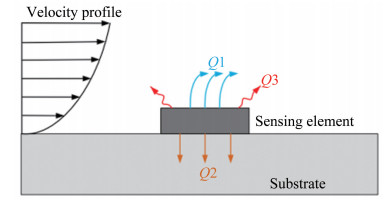
|
| 图 1 热敏式微传感器工作原理示意图 Fig.1 Schematic view of the thermal sensors working principle |
通过强制对流传热到流体中的热量为:
 (1)
(1)
式中:h是对流热转换系数,S是散热面积,T为热敏元件温度,T0为流体温度。
通过热传导耗散到衬底中的热量为:
 (2)
(2)
式中:k为衬底导热系数,A为热敏电阻与衬底的接触面积,Ti为衬底的温度,x为衬底厚度。
通过热辐射散失到流体中的热量为:
 (3)
(3)
式中:σ是Stefan-Boltzmann常数。在总的热耗散中,热辐射耗散的能量很小,可以忽略。
流体流过传感器热敏表面时,与热敏元件强迫对流换热,改变热敏元件的温度,进而改变其阻值。热敏元件阻值与温度的关系如公式 (4) 所示。通过测量传感器热敏元件的阻值变化可得到壁面剪应力的大小。
 (4)
(4)
式中:α是热敏电阻的电阻温度系数 (TCR),R0为参考温度为T0时的电阻值。
2 硅基热敏式微传感器1988年,荷兰代尔夫特工业大学Oudheusden B.等制作出了第一个基于MEMS技术的热敏式壁面剪应力微传感器[6]。封装后的传感器尺寸为9.5mm×9.5mm,包括集成在硅片上的一个热电堆和信号调理电路。由于没有对热敏单元与基底进行热隔离,热敏元件向基底的热传导较大,传感器的测试性能并不理想。
1994年,加州理工学院Liu C.等人提出了一种新型的具有真空腔结构的硅基热敏式壁面剪应力微传感器[7-8],该传感器的横截面示意图如图 2所示,热敏感表面结构如图 3所示。主要加工工艺与参数为:在硅基底上利用牺牲层技术加工出一个长宽均为200μm,深2μm的空腔;再利用低压化学气相沉积 (LPCVD) 的方法在空腔结构上方沉积热敏单元与引线结构。热敏元件的材料为多晶硅,尺寸通常为长80~200μm,宽2μm。长200μm,厚0.45μm的热敏元件标称电阻为5kΩ,TCR在20~200℃温度范围内为1300ppm/℃。在恒流工作模式下,测试系统静态灵敏度为15mV/Pa,带宽为500Hz左右,剪应力的1/3次方与传感器输出电压的平方成正比关系。在恒温工作模式下,测试系统静态灵敏度为1V/Pa,动态响应截止频率达到了9kHz。对于温度漂移问题,1999年,加州理工的Huang J.B.等人提出了一种新型的使用包括2个电阻温度系数相匹配的传感器的差分电路硬件温度补偿方法[9],电路中一个传感器工作在高过热比的恒温模式下,用于剪应力的测量,另一个传感器工作在恒流模式下,用于高灵敏度的温度测量。
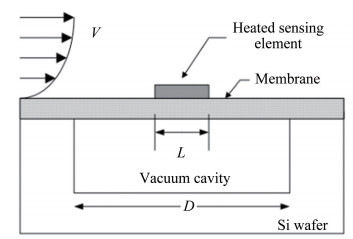
|
| 图 2 硅基热敏式壁面剪应力微传感器横截面结构示意图 Fig.2 Cross-sectional schematic of the silicon-based thermal shear-stress sensor |
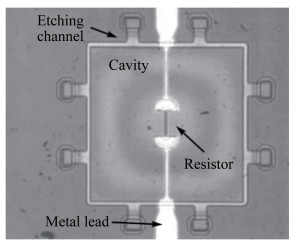
|
| 图 3 传感器热敏单元光学显微镜照片 Fig.3 An optical micrograph of the shear stress sensor sensing element |
为了多点分布式测量,1996年,加州理工学院Jiang F.等人将硅基热敏式微传感器进行了阵列化集成[10-11](见图 4)。利用各向异性刻蚀和反应离子刻蚀 (RIE) 等工艺将传统的硅基空腔结构热敏式壁面剪应力微传感器加工在了2层17μm厚的聚酰亚胺 (Polyimide) 薄膜之间。一个长3cm、宽1cm的剪应力传感器条带包含了100个传感单元。利用该传感器阵列进行了三角翼前缘分离位置检测实验[12-13]。
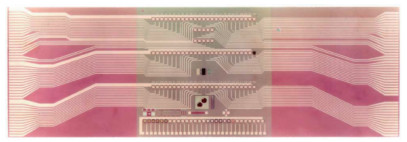
|
| 图 4 硅基热敏式微传感器条带 Fig.4 Silicon-based thermal shear stress sensor array |
相比于传统的热敏式壁面剪应力微传感器,真空腔结构的提出提高了传感器的灵敏度、带宽,降低了功耗。
2002年加州理工学院的Xu Y.等人提出使用Parylene作为防护层材料,将硅基热敏式壁面剪应力微传感器的使用领域扩展到了水下[14-17](见图 5)。研究发现采用化学气相沉积的Parylene薄膜具有优良的防水性能,沉积2μm厚度的Parylene防水层的传感器可以在55℃的水下存活至少1个月的时间。同时,对水下的压力串扰问题进行了研究,通过减小热敏元件下的隔膜层的平面尺寸和增加隔膜层的厚度,一定程度上降低了传感器在水下使用时的压力串扰。
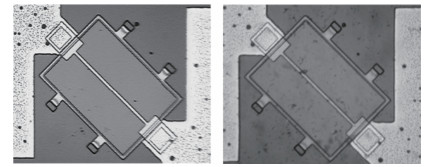
|
| 图 5 涂覆Parylene C防护层的传感器在盐水中浸泡27个月后电镜照片 Fig.5 Micrographs of a parylene C-coated shear-stress sensor (a) before and (b) after 27 months saline soaking |
多晶硅作为热敏单元电阻温度系数较低,工作温度范围较小,由于压阻效应的存在,传感器的输出会受到压力串扰的影响。2000年,佛罗里达大学的Chandrasekaran V.等人提出了以铂 (Pt) 为热敏元件材料,通过键合、减薄工艺加工出的真空腔结构实现热隔离的传感器[18-20]。传感器热敏单元尺寸为150nm×4μm×200μm,氮化硅薄膜厚度为150nm,空腔直径为200μm,深10μm (见图 6)。热敏元件两端分别为2根金导线,采用四线制进行电连接以消除引线电阻对传感器输出的影响。
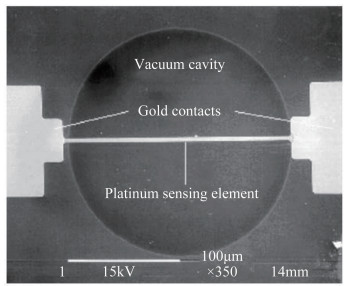
|
| 图 6 传感器热敏单元扫描电镜图片 Fig.6 Plan-view SEM of the active area of the platinum-based sensor |
相比于多晶硅材料的热敏单元,铂具有更高的TCR和工作温度范围,更小的本底噪声[21],减小了压阻效应引起的压力串扰的影响。在20~400℃温度范围内TCR最大可以达到2900ppm/℃。在恒流工作模式下对传感器进行了静态标定,过热比范围为0.2~1.0,剪应力发生范围为0~1.7Pa。实验结果如图 7所示,传感器灵敏度随着过热比的增加而升高,过热比为1.0时最大灵敏度为11mV/Pa。
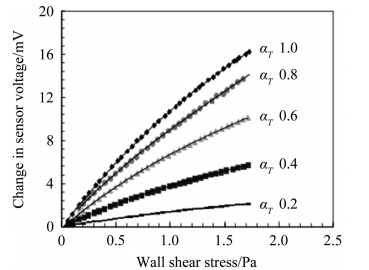
|
| 图 7 不同过热比下传感器静态标定结果 Fig.7 Static response of the sensor vs. shear stress at different overheat ratios |
此外,利用平波管对传感器进行了动态标定实验[22],结果 (见图 8) 表明传感器测试系统为一阶系统,响应频率为600Hz左右。
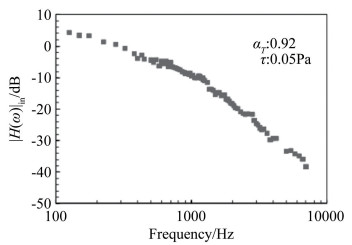
|
| 图 8 热敏式剪应力传感器动态标定实验结果 (过热比0.92) Fig.8 The dynamic calibration result of the thermal shear stress sensor (overheat ratio 0.92) |
采用牺牲层技术加工出来的硅基热敏式传感器空腔结构受到硅基底厚度和工艺的限制,无法加工出更大深度的空腔。2016年,中国科学院的Yi Ou等人利用硅玻阳极键合工艺制造出了具有真空空腔结构的热敏式壁面剪应力微传感器[23],结构示意图如图 9所示。热敏单元材料为铂,导线材料为金,空腔上方热敏元件下方的支撑结构为氮化硅薄膜,厚度为1.5μm。相比基于牺牲层技术的热敏式微传感器,该传感器拥有深度更大的空腔,最大深度可以达到525μm,真空度可以达到5×10-2Pa,封装集成后的传感器如图 10所示。静态标定实验结果 (见图 11) 表明传感器输出电压的平方与剪应力的1/3次方成正比关系,该传感器静态灵敏度可以达到184.5mV/Pa,响应时间为180μs。
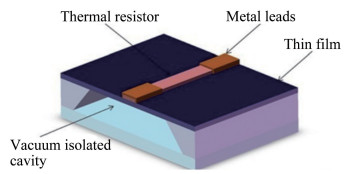
|
| 图 9 硅玻键合热敏式剪应力微传感器结构示意图 Fig.9 3D view of the proposed shear stress sensor |
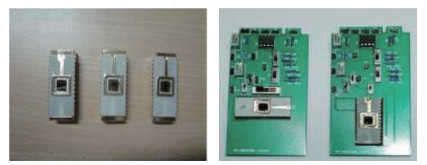
|
| 图 10 (a) 封装后的传感器; (b) 与测试电路集成后的传感器 Fig.10 (a) The packaged sensors. (b) The fully assembled sensors with test circuit boards |
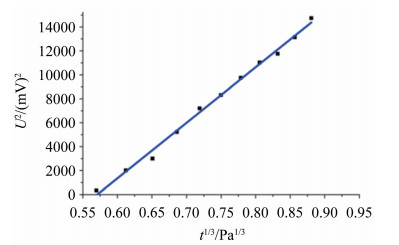
|
| 图 11 传感器静态标定实验结果 Fig.11 The static calibration result of the thermal shear stress sensor |
相对于传统的硅基热敏式壁面剪应力微传感器,柔性基热敏式壁面剪应力微传感器可实现对非平面表面壁面剪应力的大面积分布式测量,传感器的安装不会破坏模型的原有结构且几乎不会对原有流场产生干扰。
随着MEMS加工技术的发展,柔性热敏式壁面剪应力微传感器采用薄膜蒸镀、溅射、光刻和刻蚀等工艺在柔性聚合物基底上进行加工制造。2005年,德国柏林工业大学Buder U.等人研制出了一种以聚酰亚胺为基底的柔性MEMS热线微传感器[24]。该传感器以125μm厚的聚酰亚胺薄膜为基底,热敏元件为溅射在基底上的镍薄膜,厚度和宽度均为2μm,长度为800μm。热敏元件下方通过深100μm、长800μm、宽600μm的空腔与基底进行热隔离,如图 12所示。为了减小引线连接对测试流场的干扰,通过激光打孔技术实现了柔性基底上背引线的加工[25],使用该传感器进行了流动分离和再附的测量[26],如图 13所示。

|
| 图 12 聚酰亚胺基底上的热线传感器 Fig.12 MEMS wall hot-wire sensor on polyimide substrate |
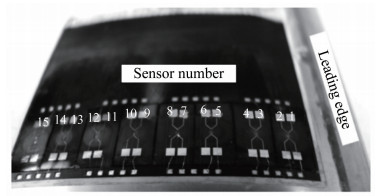
|
| 图 13 机翼模型表面的热线传感器阵列 Fig.13 The hot-wire sensor array on top surface of flap |
2005年,西北工业大学Liu K.等人开始了对柔性聚合物基热敏式壁面剪应力微传感器的研究,提出了一种将硅基热敏式传感器在柔性聚酰亚胺基底上进行阵列化集成的方法[27-33](见图 14)。传感器热敏单元材料为铂,电阻温度系数3750ppm/℃。成功进行了流动分离测量实验 (见图 15)。
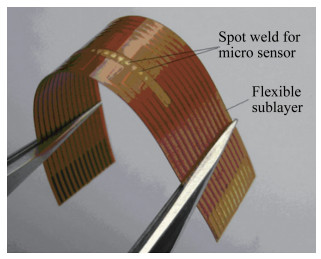
|
| 图 14 柔性基底上集成的硅基热敏式微传感器阵列 Fig.14 Silicon-based thermal sensors on flexible sublayer |
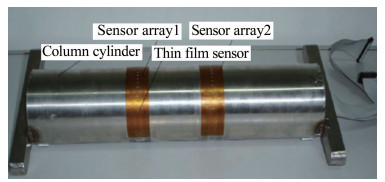
|
| 图 15 流动分离实验装置 Fig.15 Flow separation experiment device |
经过持续研究,西北工业大学Ma B.H.等人在2008年研制出了一种新型的柔性聚合物基热敏式壁面剪应力微传感器阵列[34-39]。研究建立了标准的传感器加工工艺。传感器实物图如图 16所示。采用50μm厚的聚酰亚胺薄膜为基底,热敏单元材料为溅射的镍薄膜,长3mm、宽50μm、厚1μm,电阻温度系数可达到4700ppm/℃。剪应力测量范围可达60Pa。除空气外,该传感器还可对水下壁面剪应力进行测量,采用升华法制备Parylene C作为防水涂层,厚度为2μm。水下浸泡2年后,传感器仍可以正常工作,探头阻值仅变化0.9%。
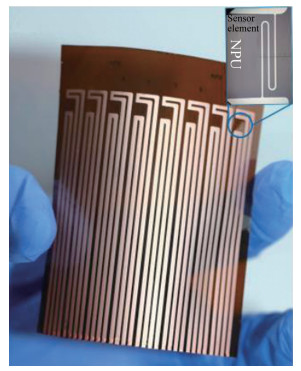
|
| 图 16 西北工业大学研制的柔性热膜微传感器阵列 Fig.16 Flexible hot film shear stress sensor arrayfabricated by NPU |
为了得到传感器输出电压与壁面剪应力的关系,进行了大量的空气和水下标定实验,部分结果如图 17和18所示,输出电压的平方与剪应力的1/3次方成正比关系。建立了恒流和恒温2种不同工作模式下的温度补偿公式以消除温度漂移对传感器输出信号的影响。西北工业大学牵头研究了壁面剪应力测量仪器技术,研制出首台套壁面剪应力测试仪工程样机 (见图 19),联合中国空气动力研究与发展中心高速所、中国商飞上海飞机设计研究院、中航工业空气动力研究院、中航工业北京长城计量测试技术研究所、中国船舶科学研究中心和南京水利科学研究院等单位,开展了标定、剪应力测量、流动分离和转捩等应用测试实验 (见图 20)。
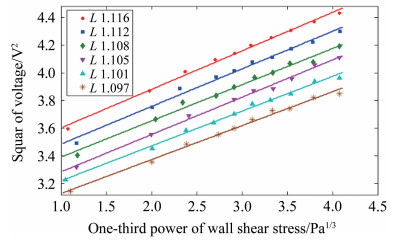
|
| 图 17 同一传感器不同过热比条件下空气静态标定实验结果 Fig.17 The static calibration result in the air at different overheat ratios |
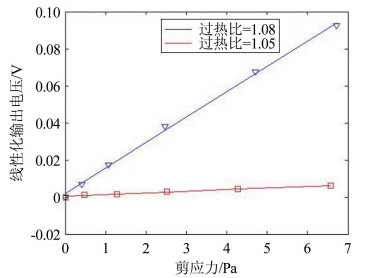
|
| 图 18 同一传感器不同过热比条件下水下标定实验结果 Fig.18 The underwater static calibration result at different overheat ratios |
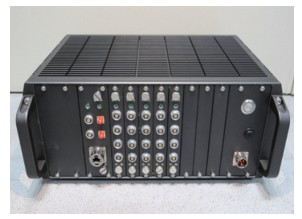
|
| 图 19 壁面剪应力测试仪工程样机 Fig.19 Wall shear stress testing instrument |
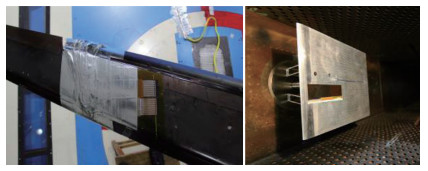
|
| 图 20 流动分离、转捩实验 Fig.20 Flow separation andtransition experiments |
2013年,德国布伦瑞克工业大学Beutel T.等人将旋涂聚酰亚胺工艺应用到了柔性热敏式传感器基底制造,研制出了以聚酰亚胺薄膜为基底的柔性热膜壁面剪应力微传感器 (见图 21),用于边界层的流动测量和飞机机翼的主动流动控制[40-42]。通过旋涂聚酰亚胺工艺,最小厚度可以做到7μm,减小了传感器对被测流场的干扰。该传感器热敏单元材料为镍,电阻温度系数可以达到4990ppm/℃。

|
| 图 21 布伦瑞克工业大学研制的柔性热敏式微传感器阵列 Fig.21 Flexible thermal shear stress sensor array |
有研究学者认为传感器表面形貌不平整会对壁面剪应力的测量造成影响。2016年,日本广岛城市大学Hasegawa Y.等人提出了一种表面光滑的柔性热敏式剪应力传感器[43],传感器结构示意图如图 22所示。在1.5μm厚的Parylene薄膜基底上加工出热敏单元和引线结构,然后将具有空腔结构的PDMS结构与Parylene薄膜基底进行粘合,使得热敏单元位于空腔结构上方 (见图 23),对热敏单元进行热隔离。该传感器敏感元件上方Parylene薄膜形成了一个光滑的表面结构,减小了传感器表面凹凸不平结构对剪应力测量的影响。
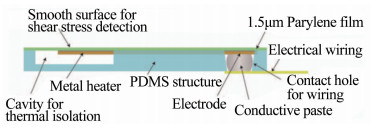
|
| 图 22 广岛城市大学传感器结构示意图 Fig.22 Cross-sectional schematic of the sensor |
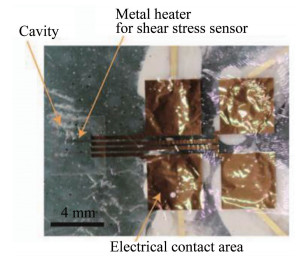
|
| 图 23 广岛城市大学剪应力传感器实物图 Fig.23 Shear stress sensor proposed by Hiroshima City University |
在生物医学领域,热敏式柔性聚合物基微传感器开始应用到生物体血管内进行壁面剪应力的测量,用于对动脉硬化等疾病的检测与预防。
2008年,美国亚利桑那州立大学的Yu H.等人提出了一种具有生物兼容性的柔性MEMS微传感器[44-45](见图 24) 用于新西兰大白兔动脉血管内壁面剪应力的实时测量。该传感器使用Parylene C作为基底材料,钛 (Ti) 和铂 (Pt) 作为敏感单元材料,热敏单元的阻值达到了1kΩ,TCR为1600ppm/℃。为了实现传感器在生物体内的使用,传感器封装成导管的形式。为了验证传感器在生物体内的适用性,将传感器植入了5只新西兰大白兔的腹动脉内 (见图 25) 进行壁面剪应力的分析测量。传感器工作在恒流模式下,工作电流为0.9833mA,测试结果如图 26所示。

|
| 图 24 柔性血管内壁面剪应力测量微传感器 Fig.24 Flexible intravascular wall shear stress sensors |

|
| 图 25 新西兰兔体内MEMS传感器荧光显微镜图片 Fig.25 Fluoroscope images of in vivo testing of the MEMS sensor in NZW rabbit |
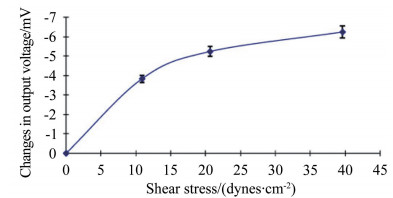
|
| 图 26 新西兰兔血管内壁面剪应力测试结果 Fig.26 The result of shear stress measurement in NZW rabbit |
由于传感器在血管内的位置会发生变化,单个传感器植入生物体内进行壁面剪应力测量误差较大。2013年亚利桑那州立大学的Tang R.等人提出了三维 (3D) 柔性热敏式传感器 (见图 27) 用于体内血液流动监测[46],以达到减小传感器在狭窄曲面结构上的位置变化引起的测量误差。该传感器有3个独立的热敏单元平均分布在封装导管上,这种排布方式引入了3个方向的独立流动信息,通过横向比较从而得到准确的流动信息。研究人员仅在生物体外对传感器进行了测试实验,并没有证明其在生物体内的适用性以及对测量准确性的具体提升效果。
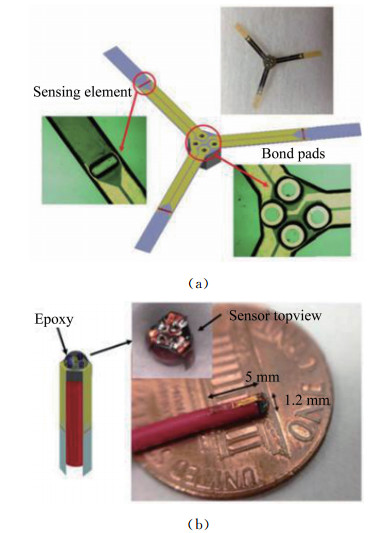
|
| 图 27 (a) 未封装的传感器; (b) 传感器封装结构 Fig.27 (a) Unwired sensing device. (b) Sensing device assembled with external wires |
为了同时对血液的多项指标进行检测,2008年,美国辛辛那提大学Li C.等人制造出了一种集成了血液温度、流速和血糖浓度测量的柔性聚合物基底芯片实验室[47](见图 28)。研究人员提出的多种传感器集成的方法不仅解决了引线连接和安装的问题,而且还保留了封装导管原有的给药和医疗工具嵌入的功能。其中的温度和流量传感器均为柔性热敏式微传感器,传感器基底选用25μm厚的聚酰亚胺薄膜,热敏单元为电子束蒸发的金薄膜,电阻温度系数为3000ppm/℃。温度和流速测试结果如图 29所示。
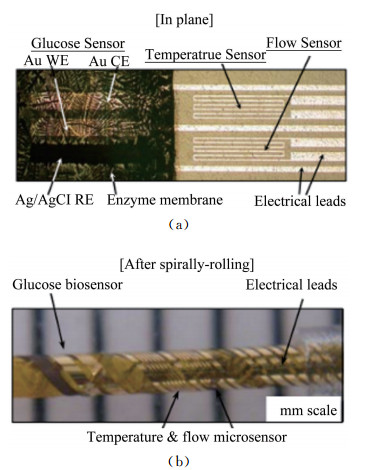
|
| 图 28 平面结构和螺旋结构的微传感器 Fig.28 In plane and spirally rolled structure of glucose, temperature and flow micro sensors |

|
| 图 29 (a) 温度传感器测试结果; (b) 流速传感器测试结果 Fig.29 (a) The test result of temperature sensor. (b) The test result of flow rate sensor |
(1) 热敏式微传感器阵列为壁面剪应力高时间空间分辨率分布式测量提供了一种有效手段。
(2) 柔性聚合物基热敏式壁面剪应力微传感器适用于非平面结构的分布测量,具有更加广阔适用性。
(3) 柔性聚合物基热敏式微传感器也可用于生物体内壁面剪应力的测量,为动脉硬化等疾病的检测与预防提供了更加高效便捷的方法和手段。
| [1] | Johnson C B, Carraway D L. A transition detection study at Mach 1.5、2.0 and 2.5 using a micro-thin hot-film system[C]. Instrumentation in Aerospace Simulation Facilities, ICIASF'89 Record, International Congress on IEEE, 1989:82-94. |
| [2] | Riedl X, Leuckert J, Engert M, et al. Transition measurement with microstructured hot film sensor arrays on a laminar flow airfoil model[M]. Berlin Heidelberg: Springer, 2013: 641-648. |
| [3] | Tokugawa N, Yoshida K. Transition detection on supersonic natural laminar flow wing in the flight[R]. AIAA Paper, 2006, 3165. |
| [4] | Naughton J W, Sheplak M. Modern developments in shear-stress measurement[J]. Progress in Aerospace Sciences, 2002, 38(6): 515–570. |
| [5] | Sheplak M, Cattafesta L, Nishida T, et al. MEMS shear stress sensors:promise and progress[C]. 24th AIAA Aerodynamic Measurement Technology Testing Conference, Florida University, 2004. |
| [6] | Oudheusden B, Huijsing J. Integrated flow friction sensor[J]. Sensors and Actuators, 1988, 15: 135–144. DOI:10.1016/0250-6874(88)87003-3 |
| [7] | Liu C, Tai Y C, Huang J, et al. Surface micromachined thermal shear-stress sensor[C]//Proceedings of the ASME Symposium on Application of Microfabrication to Fluid Mechanics, ASME Winter Annual Meeting, Chicago, 1994:9-15. |
| [8] | Liu C, Huang J B, Zhu Z, et al. A micromachined flow shear-stress sensor based on thermal transfer principles[J]. Journal of Microelectromechanical Systems, 1999, 8(1): 90–99. DOI:10.1109/84.749408 |
| [9] | Huang J B, Jiang F K, Tai Y C, et al. A micro-electro-mechanical-system-based thermal shear-stress sensor with self-frequency compensation[J]. Measurement Science and Technology, 1999, 10(8): 687. DOI:10.1088/0957-0233/10/8/303 |
| [10] | Jiang F, Tai Y C, Gupta B, et al. A surface-micromachined shear-stress imager[C]//Proceedings of 1996 IEEE Micro Electro Mechanical Systems Workshop (MEMS'96), San Diego, 1996:110-115. |
| [11] | Jiang F, Tai Y C, Walsh K, et al. A flexible MEMS technology and its first application to shear-stress sensor skin[C]//Proceedings of 1997 IEEE Micro Electro Mechanical Systems Workshop (MEMS'97), Nagoya, Japan, 1997:465-470. |
| [12] | Jiang F, Lee G B, Tai Y C, et al. A flexible micromachine-based shear-stress sensor array and its application to separation-point detection[J]. Sensors and Actuators A:Physical, 2000, 79(3): 194–203. DOI:10.1016/S0924-4247(99)00277-0 |
| [13] | Jiang F, Xu Y, Weng T, et al. Flexible shear stress sensor skin for aerodynamics applications[C]. The Thirteenth Annual International Conference on IEEE, 2000:364-369. |
| [14] | Xu Y, Jiang F, Lin Q, et al. Underwater shear-stress sensor[C]. IEEE International Conference on Micro Electro Mechanical Systems, 2002:340-343. |
| [15] | Xu Y, Tai Y C, Huang A, et al. IC-integrated flexible shear-stress sensor skin[J]. Journal of Microelectromechanical Systems, 2003, 12(5): 740–747. DOI:10.1109/JMEMS.2003.815831 |
| [16] | Xu Y, Jiang F, Newbern S, et al. Flexible shear-stress sensor skin and its application to unmanned aerial vehicles[J]. Sensors & Actuators A:Physical, 2003, 105(3): 321–329. |
| [17] | Xu Y, Lin Q, Lin G, et al. Micromachined thermal shear-stress sensor for underwater applications[J]. Journal of Microelectromechanical Systems, 2005, 14(5): 1023–1030. DOI:10.1109/JMEMS.2005.856644 |
| [18] | Cain A, Chandrasekaran V, Nishida T, et al. Development of a wafer-bonded, silicon nitride membrane thermal shear-stress sensor with platinum sensing element[C]. Technical Digest, Solid-State Sensor and Actuator Workshop, 2000:300-303. |
| [19] | Chandrasekaran V, Cain A, Nishida T, et al. Characterization of a micromachined thermal shear stress sensor[C]. 39th Aerospace sciences Meeting and Exhibit, 2001. |
| [20] | Chandrasekaran V. Dynamic calibration technique for thermal shear-stress sensors with variable mean flow[D]. Gainesville:University of Florida, 2000. |
| [21] | Jang S L. A model of 1/f noise in polysilicon resistors[J]. Solid-State Electron, 1990, 33: 1155–1162. DOI:10.1016/0038-1101(90)90094-U |
| [22] | Sheplak M, Padmanabhan A, Schmidt M A, et al. Dynamic calibration of a shear-stress sensor using Stokes-layer excitation[J]. AIAA Journal, 2001, 39(5): 819–823. DOI:10.2514/2.1415 |
| [23] | Ou Y, Qu F, Wang G, et al. A MEMS thermal shear stress sensor produced by a combination of substrate-free structures with anodic bonding technology[J]. Applied Physics Letters, 2016, 109(2): 023512. DOI:10.1063/1.4958842 |
| [24] | Buder U, Berns A, Obermeier E, et al. Aero MEMS wall hot-wire anemometer on polyimide foil for measurement of high frequency fluctuations[C]. Sensors, 2005 IEEE, 2005. |
| [25] | Buder U, Henning L, Neumann A, et al. Aeromems wall hot-wire sensor arrays on polyimide with through foil vias and bottom side electrical contacts[C]. Solid-State Sensors, Actuators and Microsystems Conference, 2007:2333-2336. |
| [26] | Buder U, Petz R, Kittel M, et al. Aero MEMS polyimide based wall double hot-wire sensors for flow separation detection[J]. Sensors & Actuators A:Physical, 2008, 142(1): 130–137. |
| [27] | 刘奎, 苑伟政, 邓进军, 等. 微型热敏传感器的薄膜电阻设计研究[J]. 中国机械工程, 2005(z1): 202–204. Liu K, Yuan W Z, Deng J J, et al. Design investigation on micro thermal sensor film resistor[J]. China Mechanical Engineering, 2005(z1): 202–204. DOI:10.3321/j.issn:1004-132X.2005.z1.069 |
| [28] | 刘奎, 苑伟政, 邓进军, 等. 基于微型剪应力传感器阵列的边界层分离点测定方法研究[J]. 航空学报, 2006, 27(1): 142–146. Liu K, Yuan W Z, Deng J J, et al. Investigation of using micro shear stress sensor array to detect boundary-layer separation point[J]. Chinese Journal of Aeronautics, 2006, 27(1): 142–146. |
| [29] | 刘奎, 苑伟政, 马炳和, 等. 微型热敏传感器系统动态特性理论研究[J]. 仪器仪表学报, 2006, 27(6): 648–652. Liu K, Yuan W Z, Ma B H, et al. Investigation in the dynamic characteristic of the micro thermal sensor system[J]. Chinese Journal of Scientific Instrument, 2006, 27(6): 648–652. |
| [30] | 刘奎, 苑伟政, 邓进军, 等. 微型热敏传感器的结构设计及仿真分析[J]. 航空学报, 2007, 28(2): 476–480. Liu K, Yuan W Z, Deng J J, et al. Design and simulation of structure of micro thermal sensor device[J]. Chinese Journal of Aeronautics, 2007, 28(2): 476–480. |
| [31] | Liu K, Yuan W Z, Deng J J, et al. Detecting boundary-layer separation point with a micro shear stress sensor array[J]. Sensors and Actuators A:Physical, 2007, 139(1): 31–35. |
| [32] | Liu K, Yuan W Z, Deng J J, et al. Sensing flow separation on a typical aerofoil by mems flexible thermal sensor array[C]. First International Conference on Integration and Commercialization of Micro and Nanosystems, American Society of Mechanical Engineers, 2007:235-239. |
| [33] | Liu K, Yuan W Z, Ma B H, et al. The fabrication and integration of a novel shear stress sensor array and its wind tunnel test[J]. Journal of Micro-Bio Robotics, 2008, 4(3): 115–120. |
| [34] | 马炳和, 赵建国, 邓进军, 等. 全柔性热膜微传感器阵列制造工艺及性能优化[J]. 光学精密工程, 2009, 17(8): 1971–1977. Ma B H, Zhao J G, Deng J J, et al. Fabrication of flexible hot film sensors arrary and its optimization[J]. Optics and Precision Engineering, 2009, 17(8): 1971–1977. |
| [35] | 马炳和, 傅博, 李建强, 等. 溅射-电镀微成型制造柔性热膜传感器阵列[J]. 航空学报, 2011, 32(11): 2147–2152. Ma B H, Fu B, Li J Q, et al. Flexible hot-film sensor array fabricated with sputtering-electroplating micromachining[J]. Chinese Journal of Aeronautics, 2011, 32(11): 2147–2152. |
| [36] | 马炳和, 王毅, 姜澄宇, 等. 柔性热膜剪应力传感器水下测量温度修正[J]. 实验流体力学, 2014, 28(2): 39–44. Ma B H, Wang Y, Jiang C Y, et al. Temperature correction of flexible thermal shear stress sensor for underwater measurements[J]. Journal of Experiments in Fluid Mechanics, 2014, 28(2): 39–44. DOI:10.11729/syltlx20140006 |
| [37] | 肖同新, 马炳和, 邓进军, 等. 基于柔性热膜传感器的流体壁面剪应力测量系统[J]. 传感器与微系统, 2013, 32(7): 101–105. Xiao T X, Ma B H, Deng J J, et al. Fluid wall shear stress measurement system based on flexible hot film sensor[J]. Transducer and Microsystem Technologies, 2013, 32(7): 101–105. |
| [38] | Li X Y, Li Y B, Ma B H, et al. Modelling and calibration of microthermal sensor for underwater wall shear stress measurement[J]. Micro & Nano Letters, 2014, 9(7): 486–489. |
| [39] | Zhu P F, Ma B H, Jiang C Y, et al. Improved sensitivity of micro thermal sensor for underwater wall shear stress measurement[J]. Microsystem Technologies, 2015, 21(4): 785–789. DOI:10.1007/s00542-014-2304-7 |
| [40] | Beutel T, Leester-Schädel M, Dietzel A. Manufacturing of flexible micro hot-film probes for aeronautical purposes[J]. Microelectronic Engineering, 2013, 111(11): 238–241. |
| [41] | Beutel T, Schwerter M, Leesterschädel M. Flexible hot-film anemometer arrays for flow measurements on curved structures[C]. SPIE 8763 Smart Sensors, Actuators, and MEMS Ⅵ. 2013:87630N-87630N-8. |
| [42] | Schwerter M, Beutel T, Leester-Schädel M, et al. Flexible hot-film anemometer arrays on curved structures for active flow control on airplane wings[J]. Microsystem Technologies, 2014, 20(4-5): 821–829. DOI:10.1007/s00542-013-2054-y |
| [43] | Hasegawa Y, Yamada T, Shikida M. Fabrication of smooth-surfaced flexible thermal sensor for detecting wall shear stress[C]. IEEE, International Conference on MICRO Electro Mechanical Systems, 2016. |
| [44] | Yu H, Ai L, Rouhanizadeh M, et al. Flexible polymer sensors for in vivo intravascular shear stress analysis[J]. Journal of Microelectromechanical Systems, 2008, 17(5): 1178–1186. DOI:10.1109/JMEMS.2008.927749 |
| [45] | Ai L, Yu H, Takabe W, et al. Optimization of intravascular shear stress assessment in vivo[J]. Journal of Biomechanics, 2009, 42(10): 1429–1437. DOI:10.1016/j.jbiomech.2009.04.021 |
| [46] | Tang R, Huang H, Yang Y M, et al. Three-dimensional flexible thermal sensor for intravascular flow monitoring[J]. IEEE Sensors Journal, 2013, 13(10): 3991–3998. DOI:10.1109/JSEN.2013.2264623 |
| [47] | Li C, Wu P M, Han J, et al. A flexible polymer tube lab-chip integrated with microsensors for smart microcatheter[J]. Biomedical Microdevices, 2008, 10(5): 671–679. DOI:10.1007/s10544-008-9178-3 |



